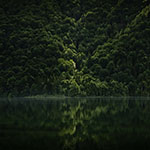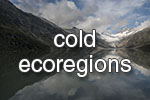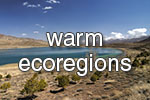Lakes in general – an overview
 Click to enlargeShallow lakes are characterized by submerged plant communities which are the main primary producers. Phytoplankton is also present but less important for primary production than in deep lakes due to grazing of zooplankters, which hide against fish predators between the macrophytes.
Click to enlargeShallow lakes are characterized by submerged plant communities which are the main primary producers. Phytoplankton is also present but less important for primary production than in deep lakes due to grazing of zooplankters, which hide against fish predators between the macrophytes.
Naturally characterized by clear water, these systems have frequently been altered into turbid states lacking macrophytes, caused by eutrophication and specific impacts that destroy the plants. Warming increases eutrophication by accelerating phytoplankton growth, nutrient release from the sediment and by supporting invasive plant species. Deep lakes are mainly found in mountainous regions and under natural conditions characterised by very low nutrient loads. Macrophytes are restricted to a narrow belt along the shores, and phytoplankton abundance is low. Even the deep zones are well oxygenated throughout the year and provide summer refuges for coldwater adapted fish. The main human impacts are acidification and – more widespread – eutrophication.
Throughout Europe the majority of lakes have been modified to some extent by human activity with agriculture and sewerage being the major contributors to eutrophication, most notably since the mid-twentieth century. As a consequence, higher algal productivity has lead to filtration problems for the water industry, oxygen depletion, recreational impairment, loss of biodiversity and an overall decline in habitat quality.
Eutrophication causes enhanced primary production, algal blooms and oxygen depletion (particularly in the deep zones) which may affect almost all processes and species. The main physical effects of warming are an extended stratification phase and accelerated oxygen depletion of the deep zones.
For further reading
- Jeppesen E, Kronvang B, Olesen JE, Audet J, Søndergaard M, Hoffmann CC, Andersen HE, Lauridsen TL, Liboriussen L, Larsen SE, et al. 2010. Climate change effects on nitrogen loading from cultivated catchments in Europe: implications for nitrogen retention, ecological state of lakes and adaptation. Hydrobiologia 663: 1–21. DOI: 10.1007/s10750-010-0547-6
link to article - Jeppesen E, Mehner T, Winfield IJ, Kangur K, Sarvala J, Gerdeaux D, Rask M, Malmquist HJ, Holmgren K, Volta P, et al. 2012. Impacts of climate warming on the long-term dynamics of key fish species in 24 European lakes. Hydrobiologia 694: 1–39. DOI: 10.1007/s10750-012-1182-1
link to article - Jeppesen E, Meerhoff M, Holmgren K, González-Bergonzoni I, Teixeira-de Mello F, Declerck S a. J, Meester L, Søndergaard M, Lauridsen TL, Bjerring R, et al. 2010. Impacts of climate warming on lake fish community structure and potential effects on ecosystem function. Hydrobiologia 646: 73–90.
link to article - Malve O, Jeppesen E, Kernan M, Goldsmith B, Bennion H, Huttula T, Duel H, Harezlak V, Penning E, Moe J, Liukko N, Ktamäki N, Taskinen A. 2012. Synthesis paper on options for lake management to improve ecological status – Resistance to climate change in focus. WISER Deliverable D5.2-6. download pdf (external source)









